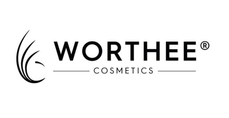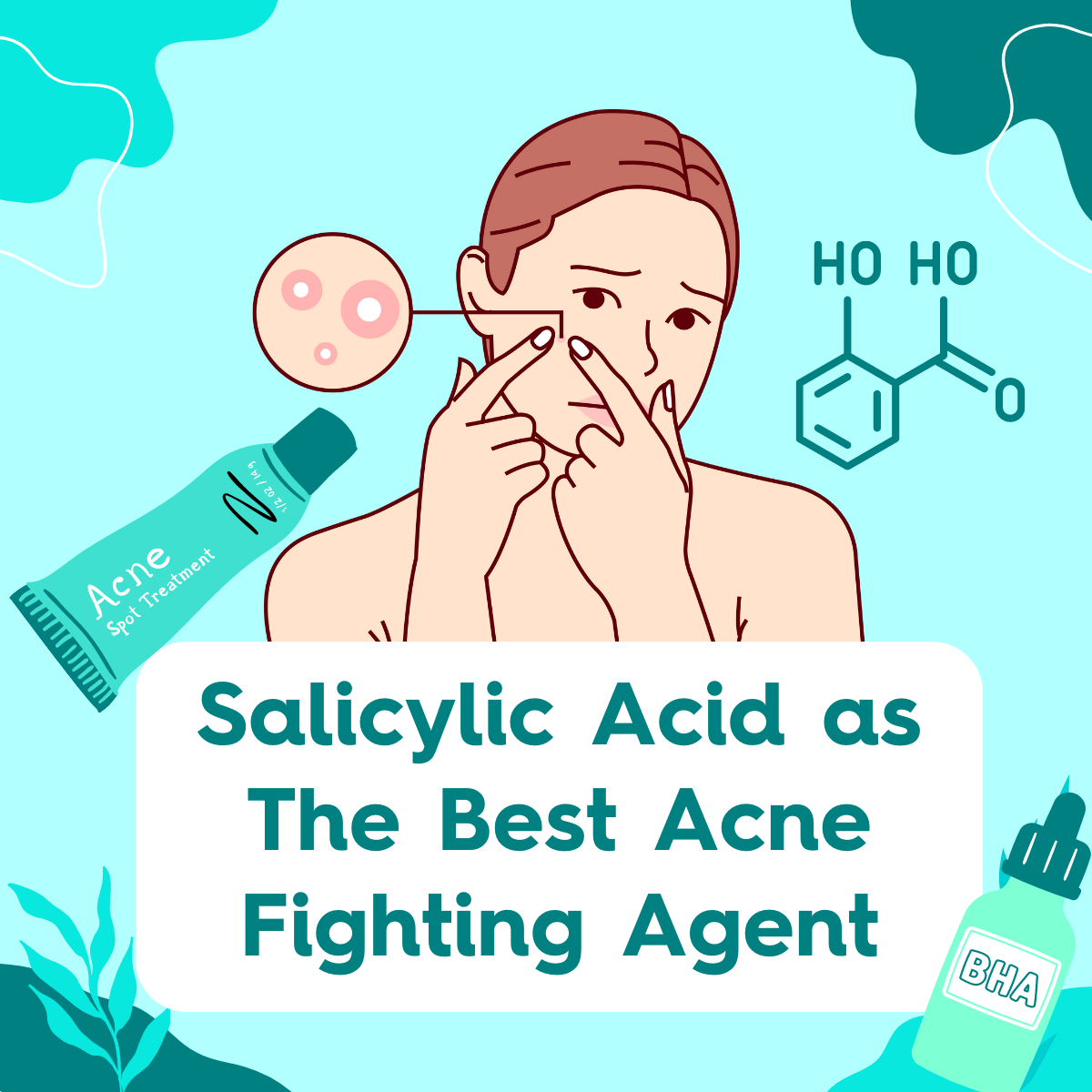If you have acne-prone skin or dealing with dullness and flakiness, you might already be familiar with the chemical exfoliation known as BHA. BHA (Beta-Hydroxy Acid) or Salicylic Acid, is an oil-soluble compound with the ability to access the oiliest part of your skin and dissolve the excessive sebum and other lipid-loving substances in your pores.
The Origin of Salicylic Acid
Salicylic Acid (SA) is derived naturally from the bark of the willow tree or wintergreen leaves. Besides that, SA also could be derived synthetically by treating dry sodium phenoxide (sodium phenolate) with carbon dioxide at high pressure of 100 atm and a high temperature of 115 °C. It is then followed by acidification of the product with sulfuric acid which would finalize the SA.

The Best Concentrations of Salicylic Acid and the Benefits
0.5% - 2% is the suggested concentration of Salicylic Acid that you could get over the counter. If you are wondering why, well here are the supportive details on why it became the jewel among the BHA family.
- Studies show that 0.5% - 2% concentrations of SA are sufficient enough to support acne treatment when combined with other ingredients such as glycolic acid.
- There is also a study that shows SA helps reduce sebum and hence, minimises enlarged pores and the formation of blackheads and whiteheads. Consistent use of SA, therefore, lessens the oiliness of the skin.
- Besides that, 2% of SA would do an amazing job in helping you to reduce dandruff on oily scalps.
Salicylic Acid of 5% concentration and above is significant in treating severe acne but only with dermatologist approval. Besides that, it is also broadly used in medicine to treat other skin diseases such as keratosis pilaris (chicken skin), psoriasis (red, itchy patches), as well as warts and corns.
The Best Leave-on BHA Formulas
Several factors determined the quality of Salicylic Acid or BHA formulations and here is the elaboration on how Worthee Cosmetics standardize it.

Solvent: No Alcohol (Ethanol)
Salicylic Acid is notorious for its difficult solubility. As an oil-soluble ingredient, ethanol is the fastest way to dissolve SA in a formulation. However, this is not the best SA formula. This is the easiest and cheapest formula in the market.
We don’t recommend Salicylic Acid dissolved in alcohol for irritation concerns. SA, by itself, in low pH, carries a certain degree of sensitization. There is less of a need to get a SA product in a high concentration of alcohol with a magnified concern of irritation, when there are other more gentle solvents in perfect ratio the chemists have repeatedly experimented to stabilize SA, such as Methypropanediol, Propanediol, Dimethyl Isosorbide etc.
Stability: No needle-like crystallization over time
Some Salicylic Acid products form needle-like crystals over time, a sign of instability that requires further research & development.
Concentration: 0.5% - 2%
As mentioned before, 2% of Salicylic Acid seems to be the gold standard with the most positive reviews with obvious and stunning results. Even so, for someone with sensitive skin, you should go for 1% SA or lower instead.
pH Level: 3.0 – 4.0
Not all 2% Salicylic Acids exfoliants are created equal. pH level largely determines SA penetration and irritation to the skin. A lower pH of 2% SA exfoliates deeper than a slightly higher pH of 2% SA. The pH range of 3.0-4.0 is documented to be skin safe.
Consistency
Generally, the form of liquid is meant for all skin types while the gel is suitable for combination-oily skin and very dry skin, lotion texture would be the best option for you.
Salicylic Acid Product Suggestions
With all of the standards mentioned above, here are some of the Salicylic Acid products that are Worthee for you to add to your skincare routine.
Paula's Choice Skin Perfecting 2% BHA Salicylic Acid Liquid Exfoliator is a gentle exfoliator with an optimal pH range of 3.2–3.8. It will exfoliate built-up layers of dead skin cells, just like your skin did naturally when you were younger. It also effectively unclogs pores, reducing blackheads and breakouts. This is a classic BHA formulation with one of the most tried-and-true reviews worldwide.
Suitable for all skin types, the texture would be a chef-kiss for all skin types; especially those with stubborn blackheads and blemish-prone skin. Not only that but it can also be used regularly to eliminate calluses on feet, elbows and knees.

Minimalist Salicylic Acid 2% is another gentle exfoliant for you. This ultra-light formulation quickly sinks into pores and smoothens roughness. Plus, it is made with Aloe Vera juice as the base instead of water to double up its soothing capacity. This face serum will be perfect for all skin types struggling with blackheads, whiteheads, breakouts or other pore-related concerns.

Geek & Gorgeous Porefectly Clear 2% BHA Exfoliating Serum ticks off our standards perfectly. It will do wonders for your skin with the addition of Sarcosine which magnifies the penetration of SA. Simultaneously, Allantoin plays a significant supporting role in moderating the skin’s response to low pH active ingredients, dramatically comforting potential adverse effectiveness and moisturizing dryness at the same time. Hence, you could experience exfoliation without irritation. Formulated for combination to oily skin struggling with acne breakouts, enlarged pores, blackheads & oily shine.

Garden of Wisdom Salicylic Acid 2% Serum uses organic and non-GMO Propanediol to stabilize BHA, at a surprisingly gentle formulation, to deliver extraordinary results. This offers a great option for vegan lovers. With an ideal pH of 3.0 – 3.5, consistent usage of this serum sheds dull layers of skin and clears pores to let skin renew and flourish as it does during younger age. This serum is perfect for all skin types, especially those prone to acne and breakouts, or with combination or oily skin.

References
Arif T. (2015). Salicylic acid as a peeling agent: a comprehensive review. Clinical, cosmetic and investigational dermatology, 8, 455–461. https://doi.org/10.2147/CCID.S84765
Brown, W. H. (2016, March 2). salicylic acid. Encyclopedia Britannica. https://www.britannica.com/science/salicylic-acid
Kootiratrakarn, T., Kampirapap, K., & Chunhasewee, C. (2015). Epidermal permeability barrier in the treatment of keratosis pilaris. Dermatology research and practice, 2015, 205012. https://doi.org/10.1155/2015/205012
Lu, J., Cong, T., Wen, X., Li, X., Du, D., He, G., & Jiang, X. (2019). Salicylic acid treats acne vulgaris by suppressing ampk / srebp 1 pathway in sebocytes. Experimental Dermatology, 28(7), 786–794. https://doi.org/10.1111/exd.13934
Pennycook KB, McCready TA. Keratosis Pilaris. [Updated 2022 Jun 27]. In: StatPearls [Internet]. Treasure Island (FL): StatPearls Publishing; 2022 Jan-. Available from: https://www.ncbi.nlm.nih.gov/books/NBK546708/
Ranganathan, S., & Mukhopadhyay, T. (2010). Dandruff: the most commercially exploited skin disease. Indian journal of dermatology, 55(2), 130–134. https://doi.org/10.4103/0019-5154.62734
Rodríguez-Cerdeira, C., & Sánchez-Blanco, E. (2011). Glycolic acid 15% plus salicylic acid 2%: a new therapeutic pearl for facial flat warts. The Journal of clinical and aesthetic dermatology, 4(9), 62–64.
Rodríguez-Cerdeira, C., & Sánchez-Blanco, E. (2011). Glycolic acid 15% plus salicylic acid 2%: a new therapeutic pearl for facial flat warts. The Journal of clinical and aesthetic dermatology, 4(9), 62–64.
Sacchidanand, S. A., Lahiri, K., Godse, K., Patwardhan, N. G., Ganjoo, A., Kharkar, R., Narayanan, V., Borade, D., & D'souza, L. (2017). Synchronizing Pharmacotherapy in Acne with Review of Clinical Care. Indian journal of dermatology, 62(4), 341–357. https://doi.org/10.4103/ijd.IJD_41_17
Wikimedia Foundation. (2022, September 8). Salicylic acid. Wikipedia. Retrieved September 10, 2022, from https://en.wikipedia.org/wiki/Salicylic_acid
Zaenglein, A. L., Pathy, A. L., Schlosser, B. J., Alikhan, A., Baldwin, H. E., Berson, D. S., Bowe, W. P., Graber, E. M., Harper, J. C., Kang, S., Keri, J. E., Leyden, J. J., Reynolds, R. V., Silverberg, N. B., Stein Gold, L. F., Tollefson, M. M., Weiss, J. S., Dolan, N. C., Sagan, A. A., … Bhushan, R. (2016). Guidelines of care for the management of Acne Vulgaris. Journal of the American Academy of Dermatology, 74(5). https://doi.org/10.1016/j.jaad.2015.12.037
Zander, E., & Weisman, S. (1992). Treatment of acne vulgaris with salicylic acid pads. Clinical therapeutics, 14(2), 247–253.
Zhang, L., Shao, X., Chen, Y., Wang, J., Ariyawati, A., Zhang, Y., Chen, J., Liu, L., Pu, Y., Li, Y., & Chen, J. (2022). 30% supramolecular salicylic acid peels effectively treat acne vulgaris and reduces facial sebum. Journal of Cosmetic Dermatology, 21(8), 3398–3405. https://doi.org/10.1111/jocd.14799


